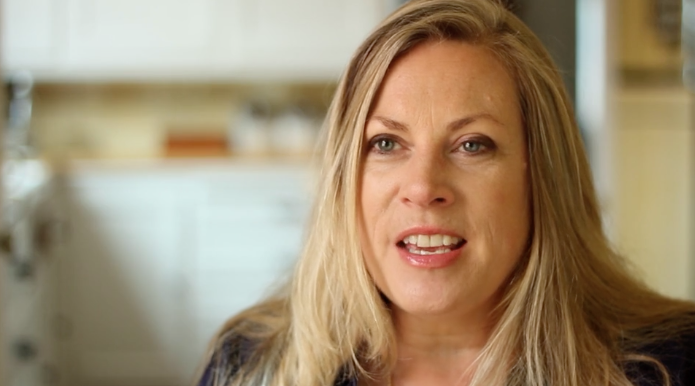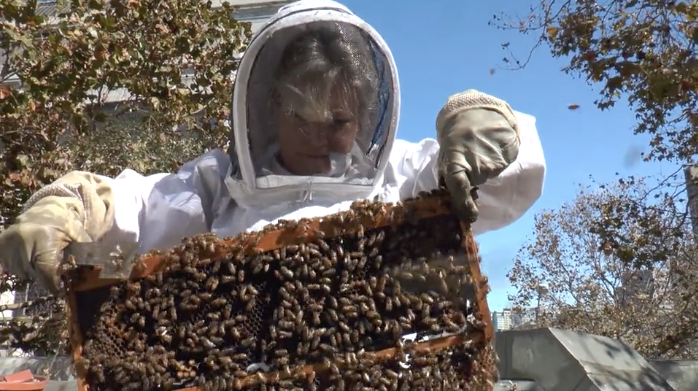It’s a honey of a job, but the payoff is in saving the creatures who foster our food
When she was 15, on a beautiful sunny day in Toronto, Canada, Terry Oxford was enjoying an outdoor jazz concert when the sky went dark. Everyone looked up as a gigantic swarm of migrating monarch butterflies made their way across the sky. Even the band stopped playing. People were so awed they applauded when the butterflies were gone.
Today, more than 90 percent of the monarch butterflies that migrate from Mexico to Canada have disappeared. Oxford, a woman now in her late 50s, finds this intolerable.

Butterflies are just one of many species, including birds, bats, native bees, honeybees (which are not natives) and many insects, that pollinate plants and are responsible for bringing us one out of every three bites of food, according to the Pollinator Stewardship Council, a nonprofit dedicated to the protection and promotion of managed and native pollinators. “Without pollinators,” says Oxford, “life on this planet would be unrecognizable.”
Since 2010 when she started her company, UrbanbeeSF, Oxford has been lining up local restaurants to help pollinators by letting her keep bees on their roof. “It’s never about the honey. But they really appreciate it when the bees make extra,” she said.
It’s well documented that bee as well as Monarch butterlfy populations are down. Thus goes the entire pollinator system, Oxford said. “Their decline is in direct proportion to the rise of systemic agrochemicals; pesticides, insecticides, fungicides and herbicides. “
Nature conservation in her DNA
Now she is raising two native pollinators, Anise Swallowtail butterflies and Mason bees. She also educates people about the vital importance of planting organic landscapes for these creatures. “After all,” she said, “what’s the point of keeping bees if you don’t provide them with organic, diverse nutrition?”
Although she makes her living as a property manager in San Francisco, Oxford’s heart has always been in environmental activism. “In Canada, there were few people and abundant open space. Nature has always been important to me, as it has been for most Canadians. It’s in their DNA.”
As a child she fell in love with the interconnectedness of nature and all life. Her early influences were Paul Watson, a Canadian-American marine wildlife conservation and environmental activist, and Canadian biologist David Suzuki and his eponymous foundation. Also host of the TV show “The Nature of Things,” his mantra is “What we do to the planet and its living creatures, we do to ourselves.”
“It’s almost interspecies sex to create new life. It is so magical, so beautiful.”
Terry Oxford
Leaving Canada in her mid-20s, Oxford and her daughter settled in Los Angeles, where she helped pass legislation that addressed the dangers of second-hand smoke. It created, she said, “the first public-space, cigarette ban in the world. When her daughter was “grown and flown,” Oxford moved to San Francisco at age 48 to complete her degree at the University of California-Berkeley, majoring in the history of ancient Rome.
She first learned about pollinators In Los Angeles, working for TreePeople, a tree-planting organization. “I learned how insects help a flower to seed. It’s almost interspecies sex to create new life. It is so magical, so beautiful.”
She also learned that pollinators were in trouble.
The largest problem for pollinators is the ubiquitous use of systemic pesticides and fungicides. Absorbed by the plant, they make their way into the pollinator’s food – the nectar and pollen. Butterflies can eat anything that can dissolve in water. Like bees, they mostly feed on nectar from flowers but also eat tree sap, dung, pollen or rotting fruit.
“More than 75 percent of ornamental landscape plants and trees are treated with a systemic poison at the nursery or grower that lasts the life of the plant,” Oxford said. “The pollinators are eating that poison and either dying immediately or later in the hive.”
The enemy: systemic insecticides
Particularly toxic to pollinators are neonicotinoids, a group of insecticides used widely on farms and in urban landscapes. Agricultural producers started using them about 18 years ago. According to the Center for Biological Diversity, not only are neonicotinoids more toxic than DDT, which was banned in the U.S. in 1972, they are failing to produce promised benefits to agricultural production.
“But for companies like Bayer/Monsanto, these poisonous chemicals are big business and their power outweighs the voices for insect-sustainable strategies,” Oxford said. The only way to guarantee the survival of all pollinators is to stop using these toxins and plant organic landscapes, she said.
“When I left Los Angeles, I wanted to do my part to help pollinators survive, and at the time, keeping bees on rooftops seemed like a crazy good idea.” Oxford had a friend with a rooftop garden and very quickly discovered she was good at raising bees.

She learned “intentional beekeeping” practices from a master teacher at the Zen Center in Marin County. Intentional beekeeping is as the ancients did it, without antibiotics, chemical interventions or pesticides added to the hives. It means raising bees to be healthy – not just to produce a product to sell.
“I don’t manipulate my hives in any way for greater profit,” Oxford said. “When people see golden honey, greed can kick in.”
One practice now viewed as highly dangerous for honeybees and a likely contributor to commercial honeybee demise is artificial sugar feeding: beekeepers take all the honey from the hive – the bees’ carbohydrate – and replace it with white sugar or cheap high fructose corn syrup.
Oxford envisioned that her own rooftop space for honeybees would be on top of a restaurant. In 2009, while she was out enjoying her regular city walks, she passed by Quince in Jackson Square. “I asked the chef if he was interested in hosting bees on his roof.” He and his crew were just discussing that idea to see if it could work in the city. “A month later, I put two bee hives on Quince’s roof.” The are still there.
Oxford then signed up the restaurants Nopa and Jardiniere as well as Heath Ceramics, to host bee hives. “I keep the hives really small to replicate natural habitat, which is inside a cavity in a tree trunk. I let them build their own honey comb – allowing for their intelligence instead of commercial plastic combs – which instructs the bees to work toward making more honey.”
If there’s honey to spare, it’s an extra
Oxford also allows the bees to keep their own honey. “If they make enough to get through the entire winter and spring, I will take a tiny amount.” With Oxford, the bees come first. She has three Good Food Awards, but she didn’t sell much honey until 2017. “It’s not about honey,” she said. “It’s about healthy ecosystems and a future for all of us.”
Because of a recent study by environmental advocate the Xerces Society saying honeybees are too numerous in cities, Oxford decided to reduce her honeybee population and expand her focus to other pollinators. “I’m now raising native Mason bees and the local Anise Swallowtail butterfly to work in organic landscape material in the city. I place them where there is ample food so they can thrive.” The Anise Swallowtail butterfly eats fennel in locations such as the Tenderloin, the Mission, the Castro, near Coit Tower and the TransBay Terminal.
Of the 4,000 bee species native to North America, Mason bees are among the easiest to raise, while also being gentle and amazing pollinators. “Native bees, not honeybees, are the best indicator species because native bees are not manipulated by humans or forced into boxes,” she said. “Thriving native bees are a true mirror of the health of any ecosystem.”
Oxford shows anyone who is interested in how to raise the little Anise Swallowtail butterfly caterpillars to chrysalis stage, and after a couple of days, release them outside to start their life as Swallowtails.
Her latest project is working with San Francisco property management companies to plant all organic, seasonal and native landscape around their buildings – safe foods for pollinators. “The building at 101 California has gorgeous landscape material and is organic from soil to seed to sapling.” And she has nine more committed sites.
Additionally, for the last two years, Oxford has been planting trees for bees from seed at a Santa Rosa Farm, BeesnBlooms.com, a CCOF-certified organic acreage. It provides a home for thousands of honeybees and native bees, cut flowers, lavender for oil production and a tree nursery of pollinator-friendly organic trees.
“Whatever we plant in these trying times for all species, it should be safe food and habitat for nature.”
Terry Oxford
“Now, there are almost 1,000 trees ready for sale” she said, “and because of the devastation from the (Northern California) fires, a lot of people will be replacing trees and plants. Whatever we plant in these trying times for all species, it should be safe food and habitat for nature.”
Oxford educates people about the need for organic planting and she gives talks to any interested groups. Contact her through urbanbeesf.com.





